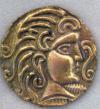Brown Dwarfs May Grow Rocky Planets, Earth-Scale Planets May Be More Common Than Expected

Astronomers using the Atacama Large Millimeter/submillimeter Array (ALMA) have for the first time found that the outer region of a dusty disc encircling a brown dwarf contains millimetre-sized solid grains like those found in denser discs around newborn stars. The surprising finding challenges theories of how rocky, Earth-scale planets form, and suggests that rocky planets may be even more common in the Universe than expected.
Credit; ESO
This artist’s impression shows these grains of cosmic dust in the disc around the brown dwarf.
Credit: ALMA (ESO/NAOJ/NRAO)/L. Calçada (ESO)
This video starts with a broad panorama of the spectacular central regions of the Milky Way seen in visible light. It zooms in to the Rho Ophiuchi star-forming region, to the brown dwarf ISO-Oph 102, or Rho-Oph 102. Then, an artist’s impression shows the disc of material around the brown dwarf, and zooms in to show how tiny grains collide and stick together, to form large grains.
Credit: ALMA (ESO/NAOJ/NRAO)/L. Calçada (ESO)/M. Kornmesser (ESO)/Nick Risinger (skysurvey.org)/Digitized Sky Survey 2 Music:movetwo
“We were completely surprised to find millimetre-sized grains in this thin little disc,” said Luca Ricci of the California Institute of Technology, USA, who led a team of astronomers based in the United States, Europe and Chile. “Solid grains of that size shouldn’t be able to form in the cold outer regions of a disc around a brown dwarf, but it appears that they do. We can’t be sure if a whole rocky planet could develop there, or already has, but we’re seeing the first steps, so we’re going to have to change our assumptions about conditions required for solids to grow,” he said.
ALMA’s increased resolution compared to previous telescopes also allowed the team to pinpoint carbon monoxide gas around the brown dwarf — the first time that cold molecular gas has been detected in such a disc. This discovery, and that of the millimetre-size grains, suggest that the disc is much more similar to the ones around young stars than previously expected.
Credit: ALMA (ESO/NAOJ/NRAO)/Digitized Sky Survey 2. Acknowledgement: Davide De Martin
Ricci and his colleagues made their finding using the partially completed ALMA telescope in the high-altitude Chilean desert. ALMA is a growing collection of high precision, dish-shaped antennas that work together as one large telescope to observe the Universe with groundbreaking detail and sensitivity. ALMA “sees” the Universe in millimetre-wavelength light, which is invisible to human eyes. Construction of ALMA is scheduled to finish in 2013, but astronomers began observing with a partial array of ALMA dishes in 2011.
The astronomers pointed ALMA at the young brown dwarf ISO-Oph 102, also known as Rho-Oph 102, in the Rho Ophiuchi star-forming region in the constellation of Ophiuchus (The Serpent Bearer). With about 60 times the mass of Jupiter but only 0.06 times that of the Sun, the brown dwarf has too little mass to ignite the thermonuclear reactions by which ordinary stars shine. However, it emits heat released by its slow gravitational contraction and shines with a reddish colour, albeit much less brightly than a star.
Credit: ALMA (ESO/NAOJ/NRAO)/L. Calçada (ESO)/M. Kornmesser (ESO) Music: movetwo
ALMA collected light with wavelengths around a millimetre, emitted by disc material warmed by the brown dwarf. The grains in the disc do not emit much radiation at wavelengths longer than their own size, so a characteristic drop-off in the brightness can be measured at longer wavelengths. ALMA is an ideal instrument for measuring this drop-off and thus for sizing up the grains. The astronomers compared the brightness of the disc at wavelengths of 0.89 mm and 3.2 mm. The drop-off in brightness from 0.89 mm to 3.2 mm was not as steep as expected, showing that at least some of the grains are a millimetre or more in size.
“ALMA is a powerful new tool for solving mysteries of planetary system formation,” commented Leonardo Testi from ESO, a member of the research team. “Trying this with previous generation telescopes would have needed almost a month of observing — impossibly long in practice. But, using just a quarter of ALMA’s final complement of antennas, we were able to do it in less than one hour!” he said.
In the near future, the completed ALMA telescope will be powerful enough to make detailed images of the discs around Rho-Oph 102 and other objects. Ricci explained, “We will soon be able to not only detect the presence of small particles in discs, but to map how they are spread across the circumstellar disc and how they interact with the gas that we’ve also detected in the disc. This will help us better understand how planets come to be.”
This research is presented in a paper in the Astrophysical Journal Letters.
Credit: ESO, IAU and Sky & Telescope
Ricci and Testi worked with Antonella Natta of the INAF-Osservatorio Astrofisico de Arcetri, Aleks Scholz of the Dublin Institute for Advanced Studies, and Itziar de Gregorio-Monsalvo of the Joint ALMA Observatory.
Credit: ALMA (ESO/NAOJ/NRAO)/Nick Risinger (skysurvey.org)/Digitized Sky Survey 2 Music: movetwo
ALMA, an international astronomy facility, is a partnership of Europe, North America and East Asia in cooperation with the Republic of Chile. ALMA construction and operations are led on behalf of Europe by ESO, on behalf of North America by the National Radio Astronomy Observatory (NRAO), and on behalf of East Asia by the National Astronomical Observatory of Japan (NAOJ). The Joint ALMA Observatory (JAO) provides the unified leadership and management of the construction, commissioning and operation of ALMA.
The year 2012 marks the 50th anniversary of the founding of the European Southern Observatory (ESO). ESO is the foremost intergovernmental astronomy organisation in Europe and the world’s most productive ground-based astronomical observatory by far. It is supported by 15 countries: Austria, Belgium, Brazil, the Czech Republic, Denmark, France, Finland, Germany, Italy, the Netherlands, Portugal, Spain, Sweden, Switzerland and the United Kingdom. ESO carries out an ambitious programme focused on the design, construction and operation of powerful ground-based observing facilities enabling astronomers to make important scientific discoveries. ESO also plays a leading role in promoting and organising cooperation in astronomical research.
Luca Ricci
California Institute of Technology
Leonardo Testi
ESO
Garching, Germany
Anyone can join.
Anyone can contribute.
Anyone can become informed about their world.
"United We Stand" Click Here To Create Your Personal Citizen Journalist Account Today, Be Sure To Invite Your Friends.
Before It’s News® is a community of individuals who report on what’s going on around them, from all around the world. Anyone can join. Anyone can contribute. Anyone can become informed about their world. "United We Stand" Click Here To Create Your Personal Citizen Journalist Account Today, Be Sure To Invite Your Friends.
LION'S MANE PRODUCT
Try Our Lion’s Mane WHOLE MIND Nootropic Blend 60 Capsules
Mushrooms are having a moment. One fabulous fungus in particular, lion’s mane, may help improve memory, depression and anxiety symptoms. They are also an excellent source of nutrients that show promise as a therapy for dementia, and other neurodegenerative diseases. If you’re living with anxiety or depression, you may be curious about all the therapy options out there — including the natural ones.Our Lion’s Mane WHOLE MIND Nootropic Blend has been formulated to utilize the potency of Lion’s mane but also include the benefits of four other Highly Beneficial Mushrooms. Synergistically, they work together to Build your health through improving cognitive function and immunity regardless of your age. Our Nootropic not only improves your Cognitive Function and Activates your Immune System, but it benefits growth of Essential Gut Flora, further enhancing your Vitality.
Our Formula includes: Lion’s Mane Mushrooms which Increase Brain Power through nerve growth, lessen anxiety, reduce depression, and improve concentration. Its an excellent adaptogen, promotes sleep and improves immunity. Shiitake Mushrooms which Fight cancer cells and infectious disease, boost the immune system, promotes brain function, and serves as a source of B vitamins. Maitake Mushrooms which regulate blood sugar levels of diabetics, reduce hypertension and boosts the immune system. Reishi Mushrooms which Fight inflammation, liver disease, fatigue, tumor growth and cancer. They Improve skin disorders and soothes digestive problems, stomach ulcers and leaky gut syndrome. Chaga Mushrooms which have anti-aging effects, boost immune function, improve stamina and athletic performance, even act as a natural aphrodisiac, fighting diabetes and improving liver function. Try Our Lion’s Mane WHOLE MIND Nootropic Blend 60 Capsules Today. Be 100% Satisfied or Receive a Full Money Back Guarantee. Order Yours Today by Following This Link.






